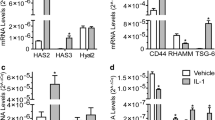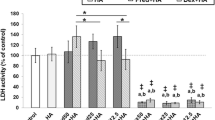Summary
Cartilage degradation is a characteristic feature of various types of human arthritis, notably rheumatoid arthritis and osteoarthritis. The influence of glucocorticoid and other steroid hormones on cartilage proteoglycan breakdown was examined in a model system in which breakdown is readily quantified by the release of proteoglycan from cultured bovine nasal cartilage discs. Endotoxin (bacterial lipopolysaccharides) treatment enhanced the depletion of cartilage proteoglycan by 2–3 fold. This was inhibited in a concentration-dependent manner by hydrocortisone (10−9 to 10−5M) or other glucocorticoid hormones (dexamethasone, prednisolone, cortisone). Inhibition required the continued presence of the steroid. Removal of hydrocortisone (3 × 10−7M) after 4 days from endotoxin-treated cultures resulted in the rapid restoration of an endotoxin response, so that proteoglycan release approached maximum levels during a second 4-day culture period. Other C-21 steroid hormones (progesterone, aldosterone) were also inhibitory at 10−5M, but testosterone and β-estradiol showed little influence on endotoxin action. Proteoglycan products of smaller average mol wt (Sepharose CL-2B chromatography), consistent with core protein cleavages, were released from endotoxin-treated cartilage. Cleavage was unaffected by β-estradiol, partially blocked by aldosterone and largely prevented by hydrocortisone administration.
Similar content being viewed by others
References
Steinberg JJ, Hubbard JR, Sledge CB: In vitro models of cartilage degradation and repair. In: I Otterness, A Lewis and R Capetola (eds) Advances in Inflammation Research. Vol. 11. New York, Raven Press, 1986, pp 215–241
Sledge CB, Steinberg JJ: Co-cultivation models of joint destruction. Cellular Interactions. In: JT Dingle and JL Cordon (eds) Research Monographs in Cell and Tissue Physiology. Vol. 6. Amsterdam. Elsevier/North-Holland Biomedical Press, 1981, pp 263–280
Steinberg JJ, Kincaid SB, Sledge CB: Inhibition of cartilage breakdown by hydrocortisone in a tissue culture model of rheumatoid arthritis. Ann Rheum Dis 42:323–330, 1983
Steinberg JJ, Sledge CB: Synovial factors and chondrocyte-mediated breakdown of cartilage: Inhibition by hydrocortisone. J Orthop Res 1:13–21, 1983
Steinberg JJ, Sledge CB, Noble J, Stirrat CR: A tissue-culture model of cartilage breakdown in rheumatoid arthritis. Quantitative aspects of proteoglycan release. Biochem J 180:403–412, 1979
Steinberg JJ, Tsukamoto S, Sledge CB: A tissue culture model of cartilage breakdown in rheumatoid arthritis. III. Effects of antirheumatic drugs. Arthritis Rheum 22:877–885, 1979
Steinberg JJ, Tsukamoto S, Sledge CB: Breakdown of cartilage proteoglycan in a tissue culturel model of rheumatoid arthritis. Biochim Biophys Acta 757:47–58, 1983
Hubbard JR, Steinberg JJ, Sledge CB: Endotoxin-induced cartilage breakdown. (Abstract). Clin Res 33:507A, 1985
Saklatvala J, Sarsfield SJ, Townsend Y: Pig intereleukin 1. Purification of two immunologically different leukocyte proteins that cause cartilage resorption, lymphocyte activation and fever. J Exp Med 162:1208–1222, 1985
Saklatvala J, Pilsworth LMC, Sarsfield SJ, Gavrilovic J, Heath, JK: Pig catabolin is a form of interleukin 1. Biochem J 224:461–466, 1984
Morales TI, Wahl LM, Hascall VC: The effect of bacterial lipopolysaccharides on the biosynthesis and release of proteoglycans from calf articular cartilage cultures. J Biol Chem 259:6720–6729, 1984
Jasin HE: Bacterial lipopolysaccharides induce in vitro degradation of cartilage matrix through chondrocyte activation. J Clin Invest 72:2014–2019, 1983
Fell HB, Jubb RW: The effect of synovial tissue on the breakdown of articular cartilage in organ culture. Arthritis Rheum 20:1359–1371, 1977
Dingle JT: The role of catabolin in the control of cartilage matrix integrity. J Rheumatol 10:38–44, 1983
Liberti JP, Miller MS: The purification and partial characterization of human somatomedin C. J Biol Chem 255:1023–1029, 1980
Van Wyk JJ, Underwood LE: Somatomedins and their action. In: G Litwack (ed) Biochemical Actions of Hormones. New York, Academic Press, 1978, pp 101–148
Hubbard JR, Liberti JP: Regulation of cartilage acid hydrolases by growth hormone. Endocrinology 110:1483–1488, 1982
Hubbard JR, Liberti JP: Enhancement of cartilage protease activity during age and growth hormone-dependent growth. Biochim Biophys Acta 673:332–338, 1981
Salmon WD Jr, Daughaday WH: A hormonally controlled serum factor which stimulates sulfate incorporation by cartilage in vitro. J Lab Clin Med 49:824–836, 1957
Saklatvala J: Characterization of catabolin, the major product of pig synovial tissue that induces resorption of cartilage proteoglycan in vitro. Biochem J 199:705–714, 1981
Saklatvala J, Sarsfield SJ, Pilsworth LMC: Characterization of proteins from human synovium and mononuclear leucocytes that induce resorption of cartilage proteoglycan in vitro. Biochem J 209:337–344, 1983
Farndale RW, Sayers CA, Barrett AJ: A direct spectrophotometric microassay for sulfated glycosaminoglycans in cartilage cultures. Conn Tiss Res 9:247–248, 1982
Dunnett CW: A multiple comparison procedure for comparing several treatments with a control. J Amer Stat Assoc 50:1096–1121, 1955
Jasin HE, Dingle JT: J Clin Invest 68:571–581, 1981
Hubbard JR, Steinberg JJ, Sledge CB: Interleukin-1 mediated release of proteoglycans. (Abstract). J Cell Biol 101:340A, 1985
Hubbard JR, Steinberg JJ, Sledge CB: Effect of purified human interleukin-1 on cartilage degradation. J Orthop Res (in press)
Bednar MS, Hubbard JR, Steinberg JJ, Broner FA, Sledge CB: Cyclic AMP-regulating agents inhibit endotoxinmediated cartilage degradation. Biochem J 244:63–68, 1987
Tyler JA: Chondrocyte-mediated depletion of articular cartilage proteoglycans. Biochem J 225:493–507, 1985
Ratcliffe A, Tyler JA, Hardingham TE: Articular cartilage cultured with interleukin 1. Increased release of link protein, hyaluronate binding region and other proteoglycan fragments. Biochem J 238:571–580, 1986
Fumarola D, Munno I, Miragliotta G, Marcuccio C: Lyme arthritis: does endotoxin play a role? (letter) Eur J Clin Microbiol 4:440, 1985
Author information
Authors and Affiliations
Rights and permissions
About this article
Cite this article
Hubbard, J.R., Mattmueller, D.R., Steinberg, J.J. et al. Effect of steroid hormones on endotoxin-mediated cartilage degradation. Mol Cell Biochem 79, 31–37 (1988). https://doi.org/10.1007/BF00229395
Received:
Accepted:
Issue Date:
DOI: https://doi.org/10.1007/BF00229395




